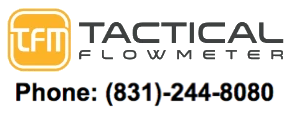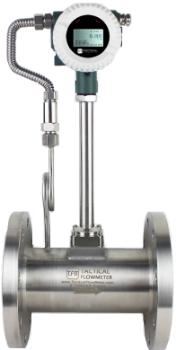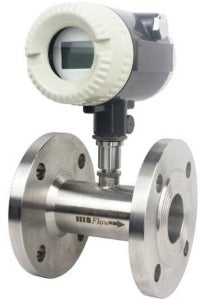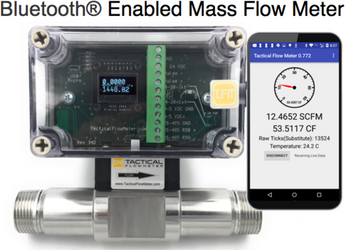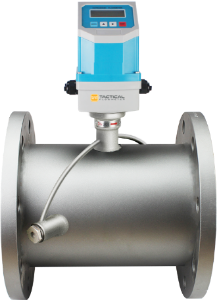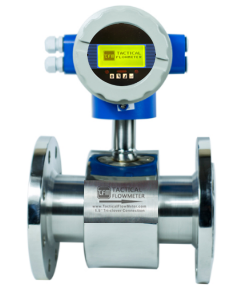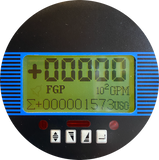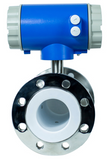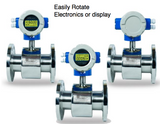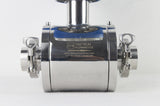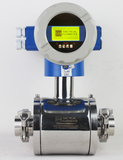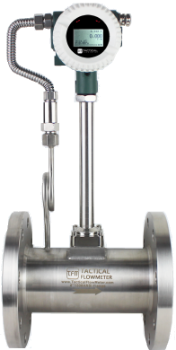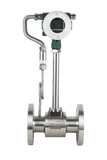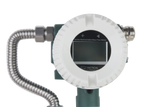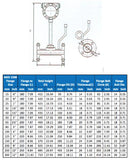Home of Big-4™️ Thermal, Vortex, Coriolis, and MAG Mass Flow Meters
The First Smart-Phone Enabled Thermal Mass Flow Meter or Controller
Configure your Mass Flow Meter-Controller with a Smart Phone
BlueTooth, Modbus RTU, USB-RS-232, 4-20mA and 0-5 VDC Outputs, Pulse Output, and an OLED Display.
Built in Datalogger with email server.
1/2" to 12" MAG Flow Meter.
Regular price
$0.00
$2,350.00
Sale
Outstanding 0.5% Accuracy and 40:1 Turndown, in 1/2" to 96" pipes, with the following liquids: Potable Water, Well Water, Waste Water, Effluent, Sewage, Sludge, Cement, Oil Well Injection Water, Beer, Wine, Liquor, Fruit Juice, Dairy, Chemical Reagent, or any electrically conductive liquid.
Available Flow Units
GPH AF/M KG/H
GPM AF/H KG/M
GPS L/H KG/S
BBL/M L/M T/H
BBL/H L/S T/M
CF/S M3/H T/S
CF/M M3/M
CF/H M3/S
Specifications
- Electrode Material: 316L SS
- Wetted Materials Teflon, 304 SS, & 316 SS
- Flow Body Material 304 SS
- Flow Velocity 0.3 - 12 m/s Nominal 0.3 - 10 m/s for 0.5% Accuracy
- Accuracy: +/- 0.5% of reading in water (From 0.3 m/s to 10 m/s)
- Repeatability of +/- 0.15% of reading
- 1/2" to 4" 150# ANSI flange connections, up to 8" available.
- LCD Display
- Temperature:
- Liquid: 14°F (-10°C) to 350°F (180°C)
- Ambient: 14°F (-10°C) to 140°F (60°C)
- Power Requirement: 24 VDC 20 Watts maximum;
- Output signals: Modbus RTU, 4–20 mA, and 0-10 KHz for flow rate indication
- Digital communications: Modbus RTU
- Proof Pressure 1.6 MPa, 230 PSIG.
- Display: Flow rate, Flow rate 0-100%, and total flow
- Wiring connection to enclosure size: M20 x 1.5
- Factory Final QC Test Certificate
- Integral Electronics
- Electronics Enclosure: IP65
Magnetic flow meters (MAG flow meters) are volumetric flow meters for measuring CONDUCTIVE LIQUIDS [Not Gases] (Min conductivity of 5 microSiemens/cm2) that operate without any moving parts and are ideal for potable water and wastewater applications as well as ideal for any conductive or water based clean or dirty fluid. Magnetic flow meters will generally not work with hydrocarbons, distilled water, and many non-aqueous solutions as they require a conductive fluid of 5 microSiemens/cm minimum.
Flow Rates
The table below gives a guideline of the nominal maximum GPM for various pipe sizes. Flows in well designed piping systems, to minimize wear and noise, and energy, are typically no more than 10 m/s max. Note these meters can easily go to 12 m/s for systems, such as high pressure fire fighting systems and blowdown systems.
Dimensions
Wiring-Plumbing:
IMPORTANT NOTE: This meter is not a "Loop Powered" device, unlike almost all temperature and pressure transducers that are loop powered. This meter takes 500 mA to run so you can see that they can not be Loop Powered. It is CRITICAL that 24 VDC is NOT connected to the 4-20 mA signal lines of COM and I+ where COM is connected to the "low" side,-, of the 4-20 mA and the I+ is connected to the "high" side,+. Your PLC has a mode in it to read these meters that does NOT involve sending power to the meter. These meters are SOURCING the 24 VDC. Connecting 24 VDC to the Current Output lines may void warranty.

View video above to see how an INSERTION MAG meter is installed, which is DIFFERENT than the flange meters on this product page. Please visit INSERTION MAG meter product listing if you discover you need an Insertion Mag Meter.
Note: The following display orientations can be ordered so the user does not have to orient in the field.

Manuals
MAG Meter Quick User Manual and Wiring Instructions.MAG Meter Quick User Manual Style 2
ModBus RTU manual for MAG meter
ModBus RTU manual for MAG meter Style 2
Cut Sheets
MAG Meter dimensions/ Installation requirements
12" ANSI Raised Face 150# Flange MAG Meter Cut sheet
8" ANSI Raised Face 150# Flange MAG Meter Cut sheet
6" ANSI Raised Face 150# Flange MAG Meter Cut sheet
4" ANSI Raised Face 600# Flange MAG Meter Cut sheet
4" 304 SS ANSI 150# RFF MAG meter CutSheet
4" TriClover MAG Meter Cut Sheet
3" 304 SS ANSI 150# RFF Remote MAG meter CutSheet
3" 304 SS ANSI 300# RFF MAG meter CutSheet
3" 304 SS ANSI 600# RFF MAG meter CutSheet
4" 304 SS ANSI 150# RFF Remote MAG meter CutSheet
3" ANSI Raised Face 150# Flange MAG Meter Cut sheet
3/4" ANSI Raised Face 150# Flange MAG Meter Cut sheet
1 1/2" TriClover MAG Meter Cut Sheet
1" ANSI Raised Face 150# Flange MAG Meter Cut sheet
2" ANSI Raised Face 150# Flange MAG Meter Cut sheet
2" TriClover MAG Meter Cut Sheet
2" 304 SS ANSI 150# RFF Remote MAG meter CutSheet
Ceramic, Al2O3, Wafer Mount MAG Meter CutSheet
Battery Powered MAG Meter Cut Sheet
Link to Copyrighted 3D STEP Files
Where to get Power Supplies, Gaskets, Nuts and Bolts Link
MAG Meter Conductivity chart for various fluids. LINK.
Refer to this chart to ensure your fluid has sufficient conductivity to honor Faraday's Law that is the essence of the MAG Meter.
Theory
MAG Meter Theory and Wiring 
As an electrically conductive fluid flow passes through the magnetic field in a MAG meter the electrically charged ions accumulate, with negative ions on one side and positive ions on the other. (Note the MAG meter actually flips the polarity of the magnetic field quickly and the ions move at the speed of light and allow easy measurement) The resulting change in voltage is directly proportional to the velocity of the fluid passing through the inside diameter of the MAG meter. This velocity is used to convert the flow to the flowing volume, usually GPM knowing the measured fluid velocity and the internal pipe diameter.
Insertion MAG meters utilize a small, localized "probe" with magnetic field that is inserted into the pipe. Electrodes cause the positive and negative ions to separate as they do in an inline flow MAG meter. Insertion MAG meters have electrodes located along the probe length to measure average velocity in the measuring location.
Battery Powered MAG Meter Specifications 
4-20 mA Connection to Battery Powered MAG meter
Videos
Battery Powered MAG Meter User instruction video overview:
Battery Powered MAG Meter Cut Sheet
MAG Meter Grounding Ring Sets
Visit Grounding Ring page here
Quick video above showing how to use the front panel buttons. The SECRET password to CHANGE variables is 03210 where 00521 is for VIEWING only. To get back to NORMAL operation hold the Enter button (the rightmost button) for 3 to 5 seconds. Password to Configure Calibration is 19818
Video above shows how to set up the Flow Units and Full Scale for those units. Note that this scaling is for driving the 4-20 mA and the frequency output so that the Full Scale value at 20 mA and at full scale Frequency is the number that is set. In this case the 4-20 and the frequency will output 20 mA and 5,000 Hz when the display shows 200 GPM. If the display goes OVER 200 GPM the 4-20 and the Frequency will increase until it "bumps it's head" on the maximum value. If the value on the display is GREATER than the value in Full Scale then one would adjust this value to accommodate the anticipated maximum value.
The video above shows how to set up the meter for Pulse and Frequency and shows how the 4-20 mA is configured. Simulating and validating the 4-20 mA output using the User Interface with 03210 is detailed below. You may ALTER these values (AnalogZero and AnlgRange) using 03210 and they will revert when you exit. Note the 4-20 mA output for this meter is POWERED by the meter. DO NOT connect to a PLC that provides 24 VDC. Connection is made to the 4-20 mA signal using a reading mode just like a Fluke Meter configured to read 4-20 mA DC. The MAG meter provides the 24 VDC for outputting the value to the INPUT of your PLC. Every PLC has the ability to be configured to read this type of 4-20 mA output. (Note: From the main menu the AnalogZero is 49 hits of the UP arrow.) (ADJUSTMENT of the 4-20 Output drive is attained using secret password of 19818 and is risky to use.) If the meter indicates a NEGATIVE flow you may REVERSE the flow using Menu 8: Flow Direction and change it from the indicated value to either the REVERSE or FORWARD value. Note: If the flow indicates a NEGATIVE FLOW number AND you know it is going from LEFT to RIGHT Menu 8 may be used to FLIP the sign. The Flow Direct is a "switch" to take care of the "Right Hand Rule" with regards to the direction of the current vector in Faraday's Law and does not require the direction to agree with the arrow on the meter. If the meter indicates a NEGATIVE flow on the display and does not output 4-20 mA it means that Menu 13: SigmaN Ena can be set to ENABLE to allow the 4-20 to indicate flow in both the + and negative direction. Set Menu 13: SigmaN Ena to DISABLE if you do not want flow to indicate if the flow reverses. In this case the mA will go to 0 mA to indicate reverse flow, but not the magnitude in rate. However, the NEGATIVE Totalizer will account for the negative flow. See video below:
IMPORTANT NOTE: This meter is not a "Loop Powered" device, unlike almost all temperature and pressure transducers that are loop powered. This meter takes 500 mA to run so you can see that they can not be Loop Powered. It is CRITICAL that 24 VDC is NOT connected to the 4-20 mA signal lines of COM and I+ where COM is connected to the "low" side,-, of the 4-20 mA and the I+ is connected to the "high" side,+. Your PLC has a mode in it to read these meters that does NOT involve sending power to the meter. These meters are SOURCING the 24 VDC. Connecting 24 VDC to the Current Output lines may void warranty. The video below shows how to VALIDATE the 4-20 mA signal into your PLC or reading device. Note: If this DOES NOT WORK a likely cause is the power supply does not have enough "power" to provide to the meter. The meter requires a MAX of 500 mA so have a power supply that has the capability to DELIVER 500 mA, even on "start up" where the inrush current given to the electromagnetic coils can rush over 500mA for a few milliseconds.
How to Reset the Totalizer in the MAG Meter. The Password to set the password for the totalizer reset is 10000. We show Clr Sum Key as the 24'th element in the menu structure. The video shows how to set the Totalizer Reset password to 10000.
How to use ModBusPoll on the TacticalFlowMeter MAG meter. Use this to ensure your configuration with your PLC is correct.
How to set the Low Flow Cutoff if your flow meter is not showing flows at very low flows. You will use this if you notice the flow meter shows 0 flow when you know there is very low flow. The meter ALSO likely has the Response time set at 10 seconds so it suppresses very low flows further. Refer to THIS chart to find the lowest readable flow on YOUR size flow meter.
Style 2 MAG Meter Interface with 4-20 mA Diagnostics and wiring diagram information.
Insertion MAG Meter overview.
View video above to see how an INSERTION MAG meter is installed, which is DIFFERENT than the flange meters on this product page. Please visit INSERTION MAG meter product listing if you discover you need an Insertion Mag Meter. Note: The following display orientations can be ordered so the user does not have to orient in the field.
View video above to see examples of LabVIEW programs we supply to Universities and some customers to assist in getting their projects online.
Video above shows the MAG meter configuration program
What causes a SYS error or SYS alarm on the MAG meter?
SYS means there is a System alarm. The reasons for it may be from the following:
1. No water in the pipe line... or
2. pipe line is not 100% filled with water... or
3. The measuring electrodes are not covered by the water... or
4. The fluid/water is too pure, the conductivity is less than 15 μs/cm... or
5. Water has entered the sensor electronics.
Note: This alarm can be disabled (Menu 24) as there is no harm in running the meter with no fluid. The purpose of the alarm is to "latch" and show itself if any of the above instances may have occurred.
1/2" to 4" Multivariable Vortex Mass Flow Meter.
Regular price
$3,410.00
Sale
A vortex flow meter is a flow measurement device best suited for flow measurements where the introduction of moving parts presents problems. They are available in industrial grade, brass or all plastic construction.
Vortex flow meter for liquids, steam & gas shipping from stock & configured for you OEM OK
EASY to use Industrial Vortex Meters. Check our stock and prices that beats our competitors.
Display
Vortex Meter Digital Display

|
See the video below to see how to use the buttons on the display within the enclosure.
Features LARGE LCD display, shows the Flow Rate, Total Flow, Temperature, and Pressure in user selectable units.
Menu
Vortex Meter Menu Details
MENU 22
Q Unit >> l/m
Q Mode >> Qvw actual (We are measuring volume flow....)
Q Factor >> 2121.47 Do Not Change (This is stamped on the side of the meter)
Density >> 875 kg/m3 (Water is 1000)
Q20mA >> 250 (FULL SCALE... If your meter is 250 l/m)
Q Cut-Zero % >> 5
Q Up Al >> 250 to turn the alarm on at 100%
Q Dn Al >> 25 to turn the alarm at 10% flow
Damp S >> 6
Comm Address >> 0
Clear Q >> Clears Totalizer, Password = 70
MENU 33
Language >> English
Pulse Type >> F_adj
Pulse Factor >> 0.01
Comm Param >> 9600, No
Comm Switch >> ON
P_display >> MEASURE
Set Pc >> 0
P0-Ref >> 101.3KPa
T_display >> MEASURE
Set Tc >> 20 Deg C
T-TYPE >> Pt=100
Tn >> 20 Deg C
Environ-T >> -20 Deg C (-10 C is fine if you do not get them cold.)
Q-adj >> DO NOT change this setting
MENU 44
Signal-TYPE >> LF: DN40-500 Lqd
Gain >> G=9
VPP limit >> 100mV
Fre-Range >> 11=34-850Hz
Work Type >> Digital
an-noise TYPE >> ANS
Signal-Adj-Set >> FIlter 10 or OFF
50Hz Cut >> ON
K-LINE ADJ >> DO NOT change this setting
Specifications
Vortex Meter Specifications
- Wetted Materials all 304 SS
- Velocity Range: See detail below.
- Velocity Accuracy: +/- 1% of reading
- Repeatability of +/- 0.05% of reading
- 1/2" to 4" 150# ANSI Flange Connections, up to 12" available custom.
- LCD Display
- Temperature Accuracy +/- 1 Deg C
- Temperature:
- Gas: -40°F (-40°C) to 482°F (250°C)
- Std Temp Liquid: -40°F (-40°C) to 662°F (350°C)
- High Temp Liquid: -40°F (-40°C) to 626°F (330°C)[Add $450]
- Ambient: -40°F (-40°C) to 131°F (55°C)
- Power Requirement: 24 VDC, 15 Watts maximum;
- 3.6 VDC Lithium C Size battery for intrinsic safety mode. Has LCD Display but no 4-20 or ModBus
- Output signals: Modbus RTU, 4–20 mA, and 0-1.0 KHz for flow rate indication
- Digital communications: Modbus RTU
- Max Pressure 1.6 MPa, 230 PSIG. (Custom up to 4.0 MPa 580 PSIG)
- Display: Flow rate, Total flow, Temperature, and Pressure
- Wiring connection to enclosure size: M20 x 1.5
- Factory Final QC Test Certificate
- Integral Electronics
- Electronics Enclosure NEMA 4X / IP67
Flow Ranges
Vortex Meter Velocity Ranges:
The Vortex meter has different minimum and maximum flow velocities it can measure based on the fluid type and meter size. Please note the values below for proper sizing of your meter.
- Steam:
- Gas:
- Liquid:
Nominal Vortex Flow Rates for Air
The table below gives the minimum, nominal, and maximum velocities for the Vortex Meter for gases to assist users familiar with Thermal Mass Flow Meter sizing guides relative to air, with a density of 0.075 lb/ft^3 for reference. As the pressure goes up the flows go up as well. For example, if the pressure is DOUBLED, so too does the mass flow. Download chart below here:
IMPORTANT Note to Thermal Mass Flow Meter users...
Did you know that Multivariable Vortex Flow Meters offer a significant advantage over Thermal Mass Flow Meters when it is not necessary to measure ultra low or ultra high flows?
Did you know that a Multivariable Vortex Meter is not affected by gas composition? This means you can change gas composition and STILL report the proper Mass Flow! Why utilize a Gas Chromatograph to determine gas composition to correct your Thermal Mass Flow Meter measurement? If you need ultra low flows it makes sense but if your minimum flows are within the measuring range of a Vortex meter then consider a Multivariable Vortex Mass Flow Meter.
As well, it is important to note that Thermal Mass Flow Meters are quite sensitive to moisture in the flow stream. The most common undesirable effect is momentary flow spikes that can upset your control system. Vortex Meters, on the other hand are NOT sensitive to moisture in the flow stream and offer a significant advantage over Thermal Mass Flow Meters if such spikes are determined to be undesirable.
Have you ever have problems with temperature swings causing your Thermal Mass Flow meter to over or under report the flow measurement? The Multivariable Vortex Mass Flow Meter does not exhibit these symptoms simply because the vortex shedding velocity is not a function of temperature or pressure. And, with the Multivariable Vortex Meters built in Pressure and Temperature sensors you can get true Mass Flow, Pressure, AND Temperature and even gather Volume flow on those rare occasions when deemed necessary. And, you have a true pressure measurement as well as the Mass Flow and temperature. All at a price very competitive with Thermal Mass Flow Meters.
HOWEVER, if you DO need very low or very high flows we suggest the use of Thermal Mass Flow Meters. As well, Thermal Mass Flow Meters are ideal as "Insertion Meters" as they are small and if, and ONLY if, there is no moisture, or gas composition changes then the Thermal Mass Flow Meter is a very good choice. Otherwise, the Vortex is the best choice as it has NO sensitivity to the gas composition or droplets or hydrocarbon particulate.
Refer to the chart above for the minimum and maximum flows for the Vortex Mass Flow Meter. Refer to the minimum and maximum velocities for the fluid you wish to use to see if a vortex meter is a good choice. If your flow is within the velocity range of the Vortex meter AND you have moisture or any change in gas composition then a Vortex meter is a better choice over the Thermal Mass Flow Meter.
Important Note: Vortex Flow Meters want to be rigidly mounted or isolated from vibration to prevent the vibrating energy to be transmitted to the Vortex Piezo Sensors. This can be accomplished by rigid mounts to a solid base or good vibration isolation.
How to use button interface and ModBus RTU video:To get the most out of the video open the link below and print out the document or open it in another window.
Dimensions
Vortex Multivariable Flange Meter Dimensions with 150# ANSI B 16.5 Flanges

Manual
ModBus commands and Meter codes
How to Invoke Variable K-Factors in the Tactical Flow Meter Vortex Flow Meter:
Screen 33 Instructions are for advanced users only. Do NOT invoke this screen on your meter unless you have a pressing need. It is important to note all settings PRIOR to making any changes. Note: Left button HOLD gets you OUT of menus.
See example spreadsheet here
Before exiting ensure you SAVE the data and CONFIRM the % numbers are ever increasing in from element 0 to element 4. The Correction ratio must be between 0.8 and 1.2.
Where to get Power Supplies, Gaskets, Nuts and Bolts Link
Important Note: Vortex Flow Meters want to be rigidly mounted or isolated from vibration to prevent the vibrating energy to be transmitted to the Vortex Piezo Sensors. This can be accomplished by rigid mounts to a solid base or good vibration isolation. We show some settings below as examples for your study. The video above shows how to enter the configuration modes.
Typical Vortex Meter Settings for reading Volume Flow for Liquids with a Full Scale of 250 l/m for a fluid with a density of 875 kg/m3 for a 3" Vortex Meter where the vortex frequency is from 34-850 Hz.
Cut Sheets
Videos
Video showing User Interface for TacticalFlowMeter.com VT-222 Series Multivariable Vortex Mass Flow Meter:
Video showing how to use the spreadsheet above and the Front Panel Interface with Menu 33:
How to verify and set up Full Scale and Units:
Refer to the Vortex Meter LCD Interface Video above for overview and introduction to using buttons.
